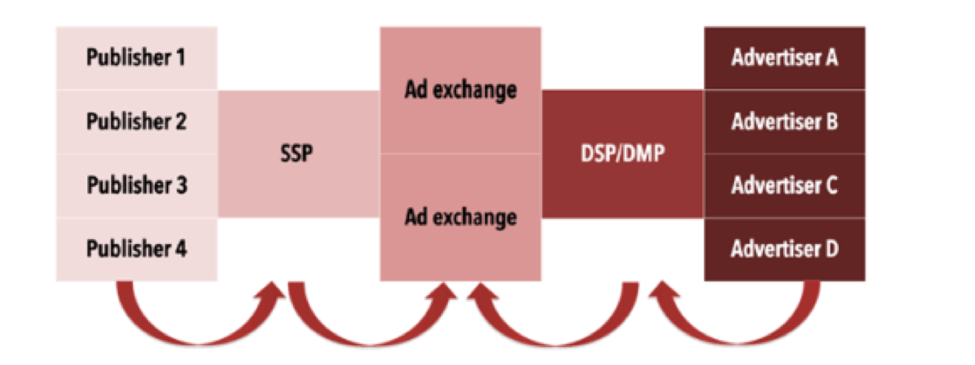
Recently, you’ve probably heard a lot about something called programmatic advertising. And if you’ve been afraid to ask what that term refers to, then you’ve come to the right place.
In its US programmatic forecast, eMarketer predicts that in 2017 more than two-thirds of all digital display advertising will be purchased programmatically. It also projects that in 2017, US programmatic digital display ad spending will reach $27.47 billion – or 72% of the total digital display ad spending in the US. Clearly, programmatic has fast become a popular means of getting brand messages out to digital audiences.
An alternative to traditional display and video ad networks
In a nutshell, programmatic advertising is an open, standards-based alternative to traditional closed display and video ad networks such as the Google Display Network.
That means that any software company that wants to may connect into the programmatic ecosystem and build services for advertisers or ad-supported websites using programmatic.
As a result, thousands of these value-added software companies (known as ‘ad tech’ companies) have emerged, providing rich tools and targeting to programmatic advertisers.
Ad tech firms provide services such as ad campaign management for advertisers (DSPs), inventory management for publishers (SSPs), ad fraud detection, brand safety monitoring, data onboarding, connecting advertisers to ad inventory, and much more.
A significant change
One significant change is the way in which ads are paid for. In programmatic, ads are bought on a cost-per-thousand-impression (CPM) basis versus a cost-per-click (CPC) basis.
CPM purchasing is more advantageous to publishers (the programmatic term for websites that feature advertising) than CPC, because publishers are paid when an ad is shown on their site— regardless of whether someone clicks on it or not.
This means publishers’ bottom lines are no longer affected by under-performing campaigns due to advertisers’ poor creative or bad targeting.
As a result, most major ad-supported websites are migrating to programmatic, making it the broadest source of quality ad inventory out there.
Programmatic: a new language
Programmatic has also led to a proliferation of new jargon to learn. Some of the most important include:
- Demand side platform or DSP is a piece of software used to purchase advertising automatically. It’s a campaign management portal most often used by advertisers and agencies to help them buy display, video, and mobile.
- Data management platform or DMP is like a huge data warehouse. DMPs map online and offline behavioral data into audiences that can be targeted through a DSP.
- Ad inventory is a publisher’s available ad space.
- Supply side platform or SSP is a tech platform that allows web publishers to manage their advertising space inventory, fill it with ads, and receive revenue.
- Data onboarding is the process of loading offline CRM (customer relationship management) data for advertising targeting.
- Programmatic direct is a way of buying ad inventory directly from a publisher at a premium price without going through an auction. Many DSPs support direct ad placements within a publisher’s premium ad positions through programmatic direct.
- Real-time bidding or RTB is a means by which ad inventory is bought and sold on per-impression basis via an automatic instantaneous auction.
- Ad exchanges are the places where ad auctions are held. They facilitate the buying and selling of ad inventory.
The highly specific targeting provided by DMPs combined with the vast inventory available from publisher sites along with the power of the emerging ad tech sector make programmatic a powerful platform for display, video and mobile advertising.
How does RTB work?
Programmatic RTB works like the Google Display Network. The ad inventory is made available via an auction model where the highest bidder wins the right for their ad to appear.
Publishers make their ad inventory available with SSPs, which in turn make the inventory available to ad exchanges.
Meanwhile, advertisers work with DSPs and DMPs to create and manage campaigns and bid on the audiences and types of placements they want.
Matches between advertisers’ bids and publishers’ inventory are made through ad exchanges, which hold real-time auctions connecting ad inventory with the highest bidding advertiser. Believe it or not, auctions are completed in the milliseconds before a webpage loads.
Real-time bidding looks like this:

The advantage of programmatic
The advantage of programmatic is that advertisers no longer have to purchase display, mobile, and video ad space for a set amount of money on a website by website basis – nor are they limited to the inventory available through a single network such as Google’s Display Network.
With programmatic, audiences can be targeted across a variety of sites and budgets can be managed in real-time.
Programmatic targeting supports many powerful features including:
- Mobile geo-fencing (a virtual fence placed around a location that when crossed sends alerts, messages, coupons or other information to a mobile user) and targeting based on app presence on mobile devices
- Targeting based on off-line CRM data (import your customer address list and target advertising to them)
- Look-alike audience modeling
- Targeting based on past search behavior
- Enhanced targeting using DMP data for ads that then run on Facebook and Google
This means that programmatic has the potential for the most precise targeting tools reaching the broadest number of websites and apps using the richest types of media at the lowest cost.
The bottom line
Programmatic allows advertisers to place targeted advertising on publishers’ websites automatically. It enjoys the richest targeting capabilities within the digital world, and is fast becoming the most effective means of getting your message out to your digital audience.
About VONT Performance Digital Marketing
At VONT we believe that change is the only constant in the digital world – and that excites us. When tools and environments are constantly changing, new opportunities to help our clients achieve success are constantly arising. Each new advertising technology, social platform, or design approach allows us to improve on the results we achieve for our clients.
We believe in this idea of continual fine-tuning so much that we named our company VONT, which means to achieve exponential improvement in incremental steps. It is our core belief, and the reason why we are not simply a web design company or simply a digital advertising agency, but rather a long-term, single source partner providing a comprehensive array of web development and digital marketing capabilities.
In short, we’re here so that our clients achieve success in the ever-changing digital world. If you’d like to learn more about VONT and the work we’ve done with our partners, visit our Work page. Or, if you have a question, contact us. We’ll get right back to you!

